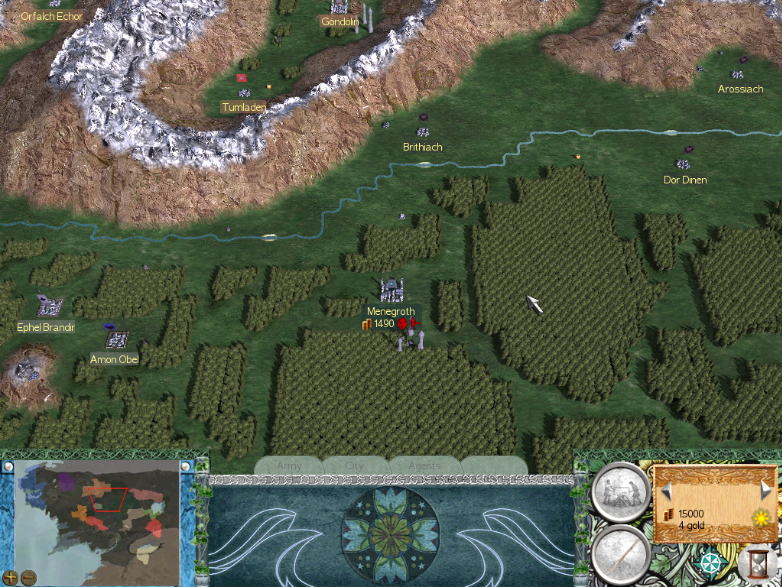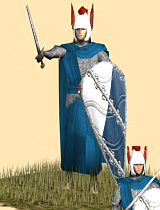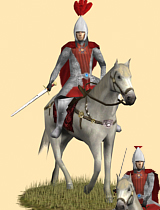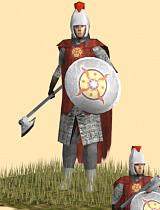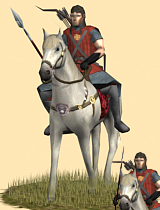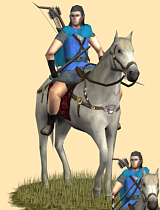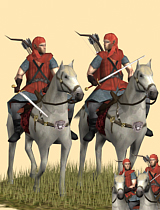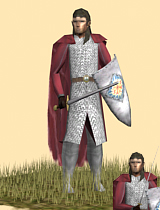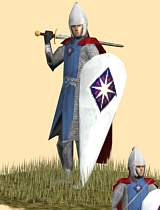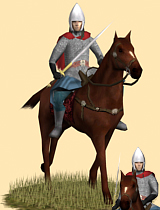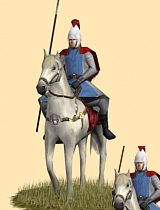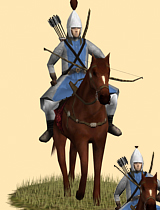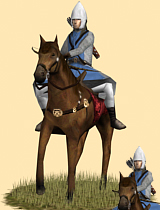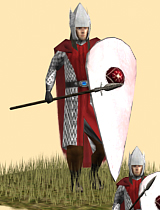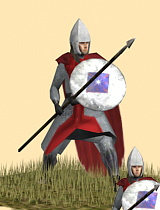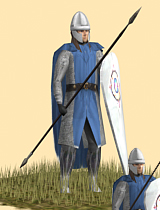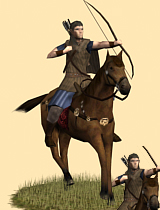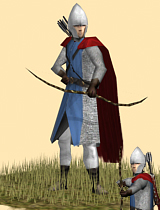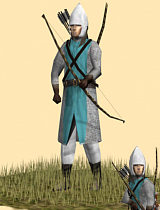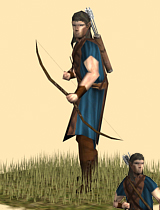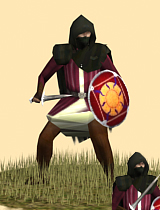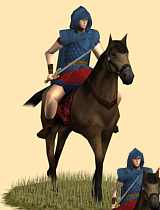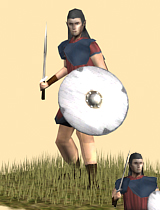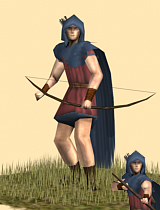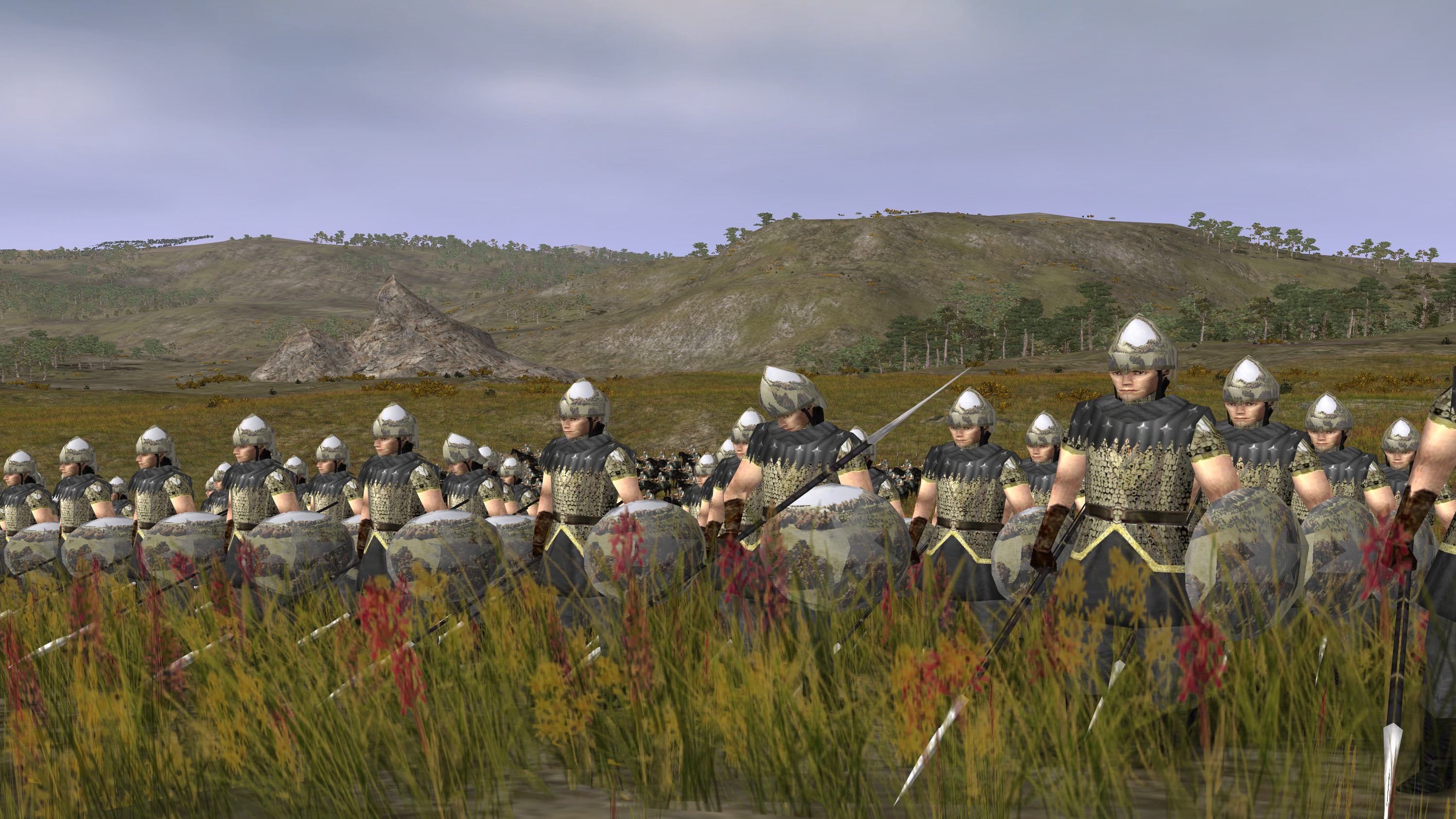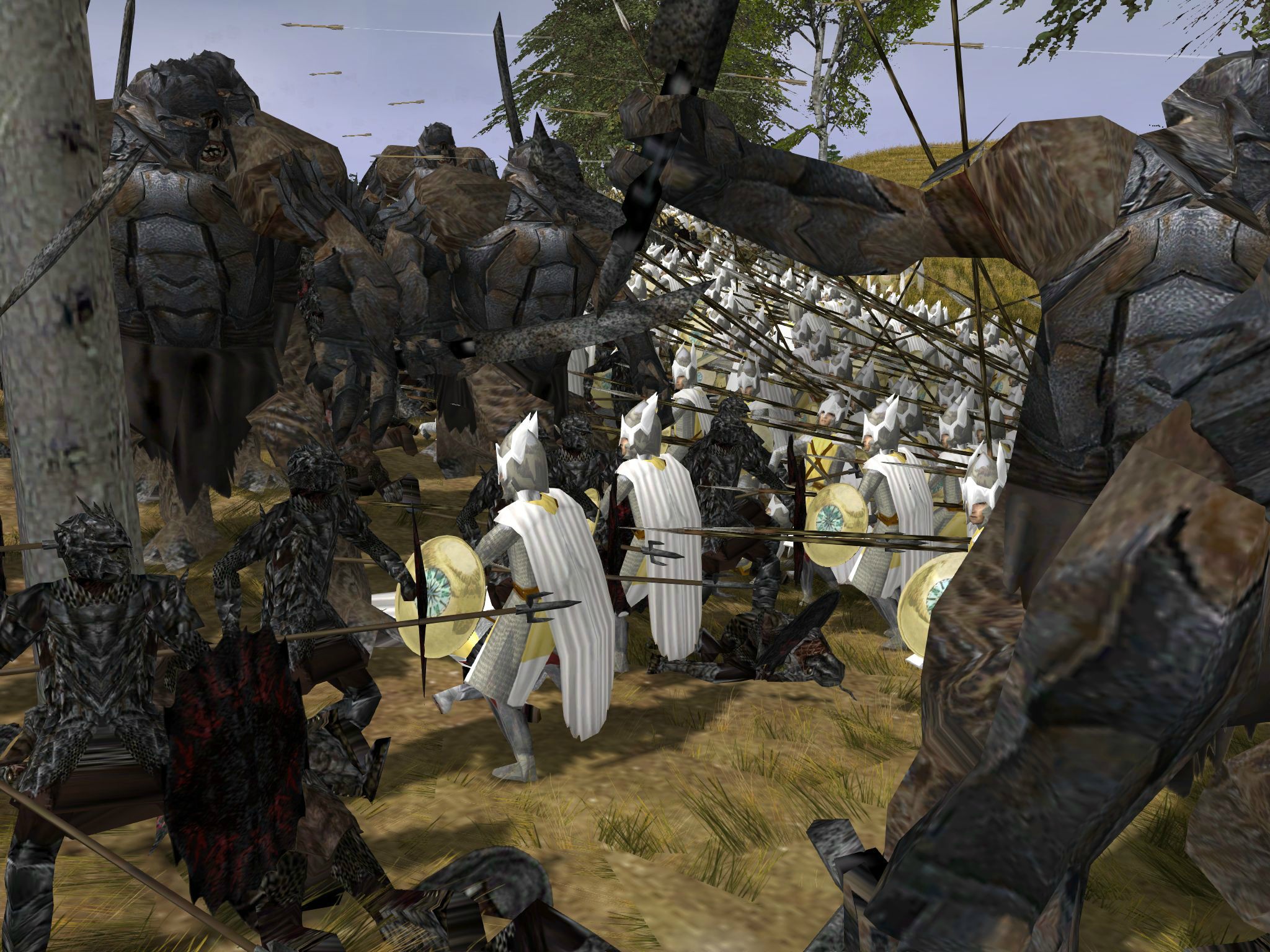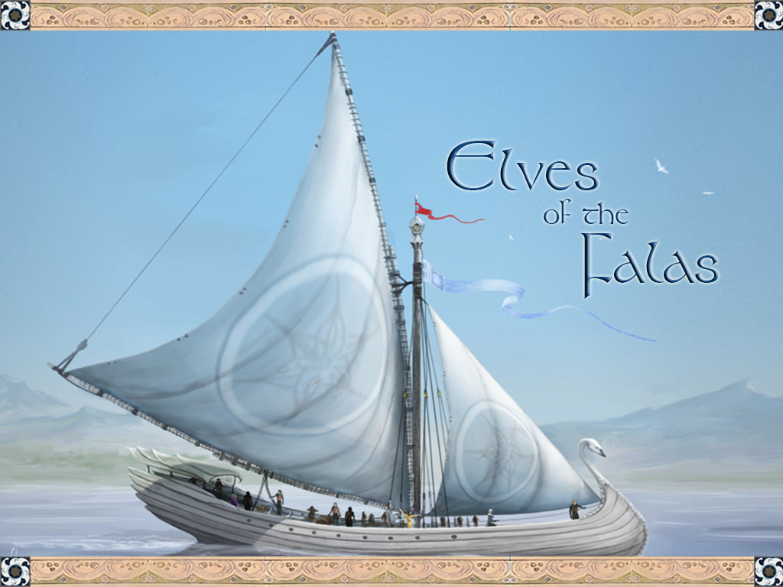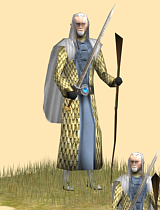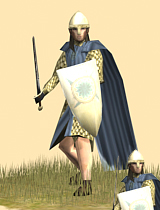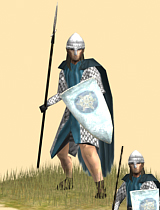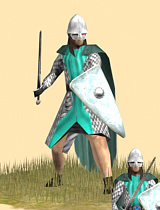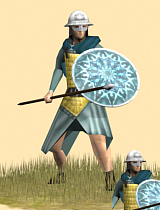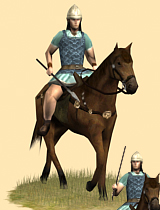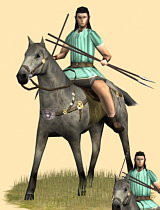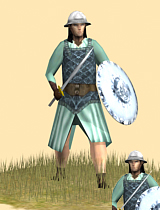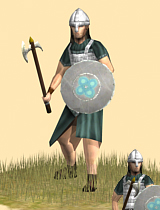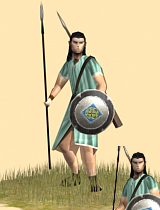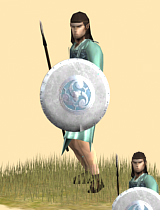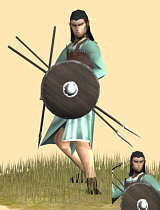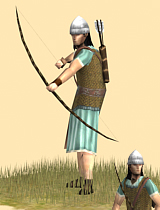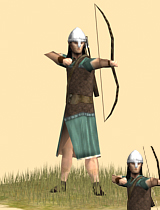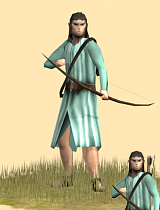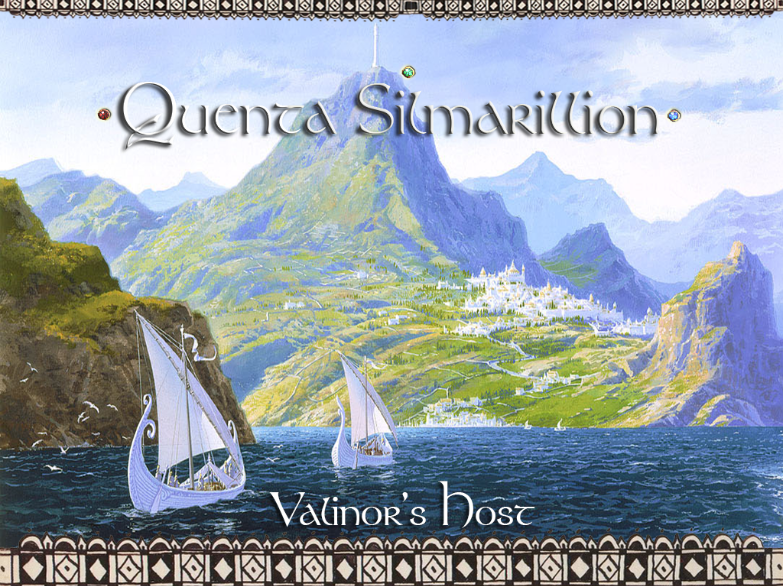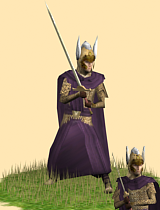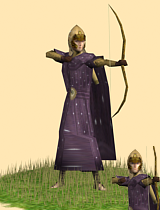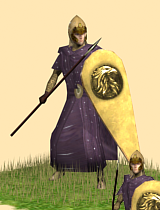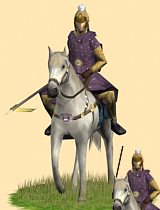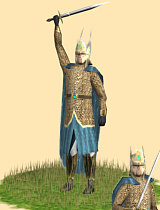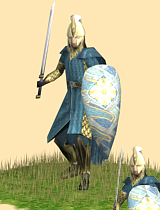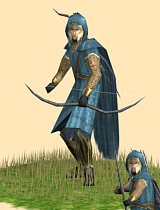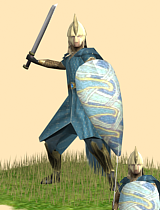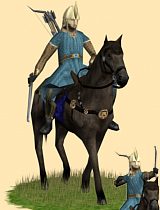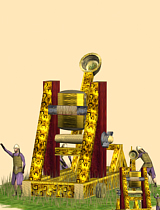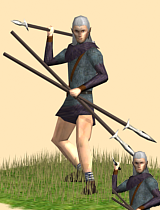The eldest son of Finwë, and half-brother to Fingolfin and Finarfin, Fëanor was accounted the greatest of the Deep Elves. He burned with a fiery spirit, from which he took his name, though he had at first been known as Curufinwë. Such was his strength of spirit that his mother Míriel passed on to the Halls of Awaiting after his birth.
In Valinor his achievements were unparalleled. Learning much craft from Mahtan, the father of his wife Nerdanel, he created gems and jewels with astonishing properties, including lamps that glowed with their own light, and the palantíri that could see over vast distances. He was also a scholar of note, and invented the letters that carried his name. Most famously of all, he captured the light of the Two Trees themselves, within three lustrous jewels made of silima that came to be known as the Silmarils.
In the time the Silmarils were made, Melkor was held chained within Mandos' halls, but at the appointed time Manwë judged that he was reformed, and should be set free. Released, the Dark Lord soon came to lust after the Silmarils for himself, and started to plan his revenge against the Valar and the Eldar. Whispering and plotting, he set a network of lies among Fëanor and his people, awakening enmity and suspicion. It was at this time that the Noldor started the making of weapons, and Melkor was quick to give them guidance and help.
At last Melkor's lies drove Fëanor to confront and threaten his half-brother Fingolfin. In the Ring of Doom Melkor's treachery was uncovered, and he fled from Valinor, but for his part Fëanor was also banished. He travelled away from Valmar with his father and his seven sons to Formenos in the north of Valinor.
Melkor did not remain hidden for long. Allying himself with Ungoliant, he descended on Valinor and destroyed the Two Trees, then disappeared in a web of darkness, making his escape from the stricken land of the Valar. Learning that Melkor had also slain Finwë and stolen the Silmarils, an enraged Fëanor assembled the Noldor and led his sons in a dreadful Oath to seek revenge against the Dark Lord. Naming Melkor Morgoth for the first time, Fëanor led the Noldor out of Valinor on the long road to Middle-earth.
Melkor and Ungoliant destroying the Trees
The journey out of the Valinor was a hard and dangerous one, fraught with betrayal and bloodshed, and many of the Deep Elves turned back, led by Fëanor's half-brother Finarfin. Fëanor himself drove onward into the cold north, denying even the Valar's warning to return, and passed across the narrow icy seas into Middle-earth.
Almost immediately, battle was joined. Morgoth's armies flooded through the mountains and descended on the host of the Noldor in Mithrim, but Fëanor and his sons were utterly victorious. That battle was fought for ten days in the darkness before the Moon's first rising, and is therefore called the Battle-under-Stars, Dagor-nuin-Giliath.
After the rout of his enemies, Fëanor's spirit burned hot, and he set out to assault Morgoth himself. With a tiny force, he charged forward, but before he could come to Angband, he encountered Balrogs. Gothmog their lord gave him a mortal wound, but was driven off by Fëanor's sons, who carried their father's body from the field. With his last breath, Fëanor cursed Morgoth, and called on his sons to fulfil their Oath and avenge him. When he died, the fire of his spirit burned away his body, leaving nothing but ash.
So the spirit of Fëanor passed back over the Sea to the Halls of Awaiting, where it still remains. His legacy was to leave his people in Beleriand, sworn to the impossible task of overcoming the Dark Lord and recovering the Silmarils. From that legacy of Fëanor grew the legends of the First Age of Middle-earth.
Source:The Encyclopedia of ArdaThe cursed descendants and followers of Fëanor, the eldest son of Finwë, and his spouse Nerdanel. Fëanor was one of the greatest, and certainly the most skilled, of the Noldor, but his burning anger at the loss of his Silmarils led him to commit acts that would greatly diminish the influence of his house among his people. As the heir of Finwë, Fëanor and his descendants should have inherited the High Kingship of the Noldor, but because of Fëanor's rash acts, the lordship of the Noldor passed to his brothers: Finarfin in Aman, and Fingolfin in Middle-earth. For this reason, the members of the House of Fëanor are referred to as the Dispossessed.
The history of the House was a woeful one, and most of its members met an early end. Fëanor and six of his seven sons perished before the end of the First Age. His second son Maglor survived beyond the War of Wrath, wandering the shores of Middle-earth, but his fate is unknown. The last of the House was Fëanor's grandson Celebrimbor, the son of Curufin, who had a great part in the making of the Rings of Power, and was tortured to death by Sauron during the Second Age.
MaedhrosSoon after coming to Beleriand, Maedhros was captured by Morgoth, and lost his right hand on Thangorodrim. After his rescue by Fingon, he built a stronghold on the Hill of Himring, from which he guarded the eastern marches of Beleriand. In the later First Age, he attempted to reconcile the Elves in the Union of Maedhros, but his attempts to overcome Morgoth ended in the disaster of the Nirnaeth Arnoediad. Nonetheless, Maedhros survived to see Morgoth's destruction in the War of Wrath, and finally fulfilled his father's Oath to recover a Silmaril. His evil acts in pursuit of that Oath, though, caused the hallowed Jewel to reject him, burning his hand when he held it. In despair, he threw himself into a fissure in the Earth.
MaglorFamed as a great poet and singer, Maglor also settled the lands to the northeast of Beleriand, in the region that became known as Maglor's Gap. After being routed in the Dagor Bragollach, he sheltered with Maedhros on Himring. He continued to fight to uphold his father's Oath, and after the War of Wrath he also took a Silmaril from Morgoth's Iron Crown, but like Maedhros he was rejected by the Jewel, and he cast it into the Sea. He was said to wander the shores of Middle-earth, mourning the lost Silmaril in despair, and was the only one of Fëanor's sons to survive into the Second Age.
CelegormHe spent the years after the Dagor-nuin-Giliath with his brother Curufin in the land of Himlad to the southwest of Himring. The two brothers held that land until the Dagor Bragollach, when they were forced to flee into the south. Coming eventually to Nargothrond, they usurped its throne and imprisoned Lúthien for a time, but were eventually ousted by the Elves of Nargothrond. Celegorm died in the assault on Menegroth, in which the brothers tried in vain to recover a Silmaril from Dior Eluchíl.
CaranthirThe most tempestuous of Fëanor's sons, Caranthir occupied a tract of land between Gelion and the Blue Mountains, and gave it the name Dor Caranthir, 'Land of Caranthir'. He made his capital beside Lake Helevorn in the north of those mountains, and was the first of the Noldor to discover the Dwarves. He was driven out of his land in the Dagor Bragollach, and later slain in the attack on Doriath with his brothers Celegorm and Curufin.
CurufinThe constant companion of his elder brother Celegorm, Curufin also dwelt in Himlad throughout most of his time in Beleriand, and later came to Nargothrond. When Curufin was eventually cast out of Nargothrond, his son Celebrimbor elected to remain behind, and so escaped his father's fate in the attack on Menegroth.
AmrodWith his twin brother and companion Amras, Amrod was a hunter in the plains of East Beleriand. Like the other sons of Fëanor, he was driven by his father's Oath, though neither he nor Amras played as great a part in history as their five elder brothers. They survived the attack on Menegroth in which Celegorm, Caranthir and Curufin fell, but when the four remaining brothers attacked the settlement at the Mouths of Sirion, Amrod and Amras were both slain.
AmrasThe twin and comrade of Amrod, who hunted the lands of East Beleriand. The twins sheltered Caranthir after he fled his land to the east, and later took part in their brothers' ill-fated assault on Menegroth. Both survived that attack, but were later killed in the attempt to recover a Silmaril from the refugees at the Mouths of Sirion.
Fëanor's only grandson, Celebrimbor (son of Curufin), played a role in creating the Rings of Power. He refused to collaborate with Sauron, Morgoth's servant, in making the Three Rings, which were the greatest Rings except for Sauron's One and which Celebrimbor forged alone in secret. But the Three were nonetheless subject to the authority of the One, which Sauron in his turn had forged alone in secret.
Source:The Encyclopedia of ArdaSons of Fëanor's regions in Beleriand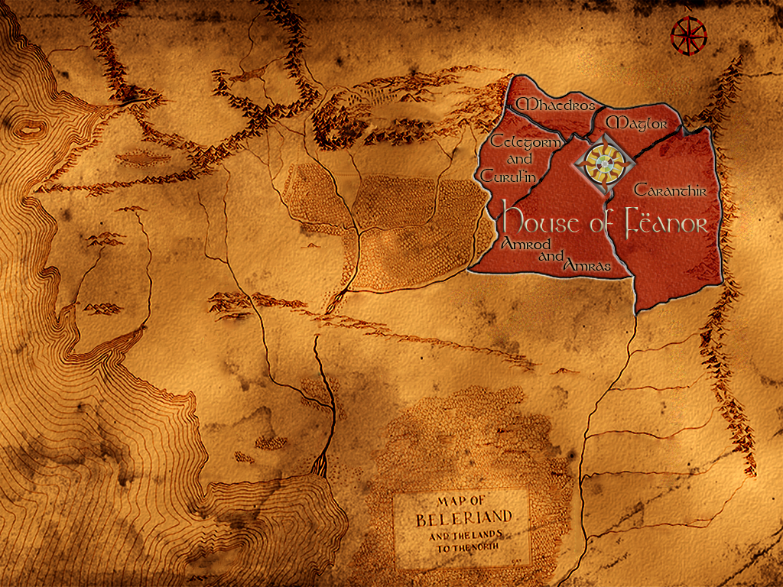

The seven Noldorin Elves who took the Oath of Fëanor with their father, and pursued it after his death in the Dagor-nuin-Giliath. Shortly after the Battle, Maedhros was captured by Morgoth and hung by the wrist of his right hand upon the face of a precipice of Thangorodrim. In a daring rescue, his cousin Fingon, helped by Thorondor the King of Eagles, saved him from torment but he had to cut off Maedhros's hand to release him from the shackle. In gratitude for this, and in atonement for Fëanor's desertion of Fingon's house, Maedhros relinquished all claim as the heir of Finwë and made his uncle Fingolfin, Fingon's father, High King of the Noldor, something his brothers did not like.
Maedhros being rescued by Fingon
Seeing that his brothers were likely to cause feuds with their kinsmen, Maedhros moved them out of Hithlum, and later ruled the lands around the Hill of Himring, which became known as the March of Maedhros. Allied with Fingolfin, he won the battle of Dagor Aglareb, and, thanks to his daring deeds during the Dagor Bragollach, Himring stood while many other elven realms fell.
Maglor's ward was the opening in the hills between the two arms of the Gelion River which acquired the name of Maglor's Gap. Due to the lack of hills the Gap was a natural route for attacks from the north and the Noldor kept a strength of cavalry in that region. Celegorm dwelt with his brother Curufin in Himlad, a pass that led into Kingdom of Doriath, which the two brothers fortified and held until the Dagor Bragollach.
Caranthir's realm was in Thargelion, and was sometimes called Dor Caranthir ("Caranthir's Land"). His abode was on the shores of Lake Helevorn. In the year 420 after The Return of the Noldor, Caranthir rescued Haleth and her people, the Haladin, as they were besieged by Orcs. When he saw the valor of Men, he offered the Haladin a fiefdom in his lands to the North. However Haleth, wanting her people to serve no lord, thanked him but removed to the Forest of Brethil.
Amrod dwelt in the wide plains of East Beleriand with his twin brother Amras, and was known as a great hunter.
So, After the Dagor-nuin-Giliath the Noldor of Beleriand (including the Sons of Fëanor) had wasted their chance to destroy Morgoth's forces quickly, and instead had been building their numerous realms and establishing contacts with the Sindar. As the Ered Engrin spewed forth fire, Morgoth sent forth numerous small bands of Orcs, which passed through the Pass of Sirion in the west and Maglor's Gap in the east. Fighting small battles along the way, they penetrated deep in West and East Beleriand, where they were destroyed by southern forces of the Noldor and Elves under Círdan of the Falas. In the east, Maedhros, Maglor and their brothers hunted down other roving bands of Orcs as they penetrated Maglor's Gap and operated in Ossiriand.
Thingol refused to march besides the sons of Fëanor, and thus no help came from Doriath. The Laiquendi of Ossiriand fought no more battles after their leader had been killed in the First Battle of Beleriand, and they also played no part in the current struggle.
Meanwhile, the main force of the Orcs spewed forth from Angband across the plains to the highlands of Dorthonion, where the brothers Angrod and Aegnor held them off. Soon armies under Fingolfin and Maedhros counter-attacked on the plains of Lothlann and Ard-galen, from both east and west. The Orc armies were caught between the hammer and anvil of the two elven forces, with most of the Orcs being destroyed, and the remnant retreating towards Angband. The Noldor pursued them, and utterly destroyed what remained of their enemies within sight of the peaks of Thangorodrim. Thus the Dagor Aglareb, the Third Battle of Beleriand, was won.
400 years later, Morgoth broke the Siege of Angband. On a winter's night, Morgoth sent out rivers of flame, consuming Ard-galen, which was renamed Anfauglith. Many elves perished as they fled from these flames, from the fire and the smoke. His armies of Balrogs and Orcs, led by Glaurung first of the Urulóki, overran the highlands of Dorthonion, and slew Angrod and Aegnor. Maglor's horsemen were burnt alive on the plain of Lothlann, and Maglor's Gap was taken, giving Morgoth an entry into Beleriand itself. Maglor retreated with heavy losses to Himring, where he helped defend the city of Maedhros.
The Pass of Aglon was also breached, and Celegorm and Curufin fled south of Doriath to Nargothrond. Morgoth's Orcs took the mountain forests of Mount Rerir, and defiled Lake Helevorn, scattering south through Thargelion into East Beleriand. Caranthir fled to Amon Ereb, where he and Amrod built defenses. From there they slowly freed East Beleriand of the Orcs, while Maglor and Maedhros held the northern border.
Minas Tirith in the Pass of Sirion in the West under Orodreth held, and Orodreth's brother and Lord Finrod Felagund came north from Nargothrond with a large army. However, they were ambushed by a large army of Morgoth's forces at the Fen of Serech. The Noldor now found themselves trapped, and Finrod would have been killed but for a sortie by Barahir, who descended from Dorthonion and rescued the Elven lord. It was this deed which later earned Barahir the ring of Finrod which would become known as the Ring of Barahir.
Finrod and his folk fled south to Nargothrond, while Barahir continued defending Dorthonion. The mountain forts of the Ered Wethrin around Hithlum also held, although barely.
Thus the Siege was broken, the Sons of Fëanor scattered, and the forces of Morgoth roamed at will throughout the north.
When Fingolfin, the High King of the Noldor, learned of the losses of so many Noldor, he rode in anger across the dust of Anfauglith and challenged Morgoth to single combat. At the doors of Angband itself, they fought a great duel. Fingolfin's sword, Ringil, wounded Morgoth seven times. Yet, he was felled by Morgoth's hammer, Grond, and slain by Morgoth's mighty foot. That was Dagor Bragollach, the Fourth Battle of Beleriand.
Almost two decades after Dagor Bragollach, Maedhros heard words of deeds of Beren and Lúthien. He took hope and gathered his brothers and united with other Elven Houses to create the Union of Maedhros, an alliance to lay siege to Morgoth's fortress of Angband. He did succeed in uniting the three kindreds in war against Morgoth. All the Elves of Beleriand, as well as the Edain, Dwarves, and the newly arrived Easterlings were invited to combine in arms and fight Morgoth. The Union first cleared Beleriand and Dorthonion of Orcs, and then gathered to assault Thangorodrim.
The plan was for Maedhros's host in the east to assault and draw out the army of Angband, after which Fingon's host would attack from the Ered Wethrin, taking the offensive in the west, crushing Morgoth's forces between them. Under Maedhros in the east were gathered the remainder of the sons of Fëanor, the Elves and Men of Himring under Maedhros and Bór, and the men of Amon Ereb under Caranthir and Ulfang. Under Fingon in the west were gathered the Elves and Men of Hithlum, the Elves of the Falas, the Haladin of Brethil and the companies sent from Nargothrond and the two elves of Doriath, Beleg and Mablung.
Because of the evil deeds of Celegorm and Curufin, two of Maedhros's brothers, Nargothrond would send only a small company of Elves under Gwindor. From Doriath, where Thingol had sworn never to fight beside any son of Fëanor, came only Mablung and Beleg, who did not wish to remain behind. However, Turgon unexpectedly came forth with over ten thousand Elves from Gondolin, doubling the force of the west.
But Morgoth through his spies had learned of the battle plan, and his spy Ulfang, who betrayed the Noldor, delayed Maedhros' attack. Meanwhile a small force of Orcs sallied forth from Angband, provoking the western host. Within sight of the Ered Wethrin, Gwindor's brother Gelmir, captured during the Dagor Bragollach, was brought forth, and brutally slain. Enraged, Gwindor broke ranks, and with him most of Fingon's troops. Their rage was so great that they nearly destroyed the western Orc host and foiled Morgoth's plans.
It is said that Morgoth trembled as Gwindor's company pounded at his gates. They burst through, and slew the guards on the steps of Angband. But alas, they were surrounded by hidden forces, and all were slain or taken. From hidden gates around Angband thousands of Orcs erupted, driving back the host of Fingon from the walls. The Elven army was driven back with great slaughter, and many Haladin fell fighting in the rearguard.
Turgon, who had withheld his host from the reckless charge, now came upon the Orc host. The phalanx of Turgon broke through the Angband lines, and met with the guard of Fingon.
Finally Maedhros arrived, but before he could make junction with Fingon and Turgon, Glaurung the dragon and Gothmog lord of Balrogs intercepted him. Union forces could yet have prevailed, but Uldor, son of Ulfang and a traitor, turned ranks and attacked Maedhros in the rear, while more of his kin came down from the mountains and attacked from the east. Maglor himself slew Uldor, but under assault from three sides, the eastern host was scattered, and only the valour of the Dwarves of Belegost helped them escape, as their lord Azaghâl and his forces held off Glaurung, allowing the sons of Fëanor to escape into Ossiriand.
Azaghâl and his army fought with fierce iron masks on, and they were able to resist the fire far better than any Elf or Man. Then Glaurung trampled Azaghâl beneath his feet, but Azaghâl ran a dagger through Glaurung's stomach, and the dragon fled in pain. With him fled many of the host of Morgoth. In a solemn ceremony the Dwarves picked up their fallen leader, abandoning the battle, and marched him home in a great procession. Their wrath was so great that none troubled them.
All this had not helped the western host, who were attacked by many Orcs under Gothmog. Fingon fell under his might, and Húrin begged Turgon to retreat back to Gondolin. Huor and Húrin and the remaining Men of Dor-lómin formed a living wall across the Fen of Serech, buying time for Turgon to escape with most of the surviving Elves of the north. Acting as a rearguard, these Men were almost all slain – Huor fell when his eye was pierced by a poisoned arrow, but his brother Húrin was captured alive by Gothmog after he was pinned under a mountain of slain Orcs and Trolls.
Morgoth's victory was near complete, as he had destroyed all the people of Hithlum and had scattered the sons of Fëanor away from Himring. Morgoth's Orcs razed all of Beleriand except for Doriath, which was still protected by the Girdle of Melian, and sacked the havens of the Falas.
Morgoth betrayed his servants the Easterlings, shutting them in Hithlum under penalty of death, and denied to them the fertile lands of Beleriand. Still Morgoth knew fear, for Turgon, now High King of the Ñoldor after the death of Fingon, had survived, and his city Gondolin was still unknown to Morgoth. To be sure, the Union's attack inflicted grievous losses on Morgoth's forces, and it would take some time for him to rebuild his armies back to their former strength. But this was largely irrelevant, compared to how utterly Morgoth had broken the power of so many of his enemies in the battle.
Maedhros had learned that Elwing of Doriath, granddaughter of Lúthien and Beren, had inherited the Silmaril that they had recovered from Morgoth. Still driven by the Oath, he allowed his brother Celegorm to convince him to attack Doriath. Celegorm, Caranthir, and Curufin were slain by Beren's son, Dior Eluchíl, the King of Doriath, who was in-turn slain by them. Dior's sons, Eluréd and Elurín, were captured and abandoned by Celegorm's servants in the forest, leading Maedhros to search for the innocent youths. After learning that Elwing had survived, he and his surviving brothers descended with an army upon the remnants of the people of Doriath living in the Havens of Sirion. The Noldorin princes killed many Elves and captured Elwing's sons Elrond and Elros in the sack, but she and her husband Eärendil escaped to the West with the jewel.
Maglor taking pity upon Elros and Elrond

Eärendil, wearing the Silmaril on his brow, came to Valinor, the first with mortal blood to set foot there, and begged the Valar to help the enslaved Elves and Men of Middle-earth.
The Valar were moved by Eärendil's plea, and along with the Vanyar and Noldor that were in Valinor, riding in the ships of the Falmari, came to Middle-earth in a mighty host. Still bitter about the First Kinslaying, the Teleri did not participate in the war. The Host marched across Beleriand, and met the forces of Morgoth in the plains of Anfauglith.
Eärendil's arrival at Tirion

The Valar and the Elves destroyed the Balrogs, all save a few who fled and hid themselves, and the armies of the Orcs perished like straw in a great fire. While the Three Houses of the Edain fought with the Valar, many other Men fought against them and perished. Facing defeat, Morgoth released his ultimate weapon, the winged Dragons, which had never been seen before, and drove the Valar back. The leader of these dragons was the powerful Ancalagon the Black.
Then Eärendil came with his sky-ship Vingilot, along with the Eagles, and they fought the dragons. In the end Eärendil slew Ancalagon, the mightiest of the dragon horde, who broke the towers of Thangorodrim in his fall.
Morgoth was captured hiding in the deepest dungeon of Angband and bound with his old chain Angainor; the two Silmarils still in his possession were taken by the Maia Eönwë and guarded. In the end the Valar thrust him "through the Door of Night, beyond the Walls of the World, into the Timeless Void", where he remains until the Last Battle and the Day of Doom. Only then shall he be utterly destroyed.
But Maedhros and Maglor stole the last two Silmarils from the camp of Eönwë, but their evil deeds in recovering them meant that the hallowed Jewels rejected their claimants. Maedhros in anguish threw himself into a fiery fissure, and Maglor in despair cast his Jewel into the Great Sea. Legend says that he still wanders the shores of the World, singing laments for his despair and regret.
Maedhros Casts Himself into a Chasm Maglor Casts a Silmaril into the Sea
Maglor Casts a Silmaril into the Sea
Source:Tolkien GatewayThe dreadful irrevocable oath taken by Fëanor and his seven sons in the city of Tirion. They swore in the name of Ilúvatar that they would not rest until the three Silmarils were in their hands, and to make war on any who withheld them. Tolkien remarked that it was an oath which should never have been taken, reflecting on the Biblical passage concerning such oaths.
At the time the Oath was sworn, Morgoth held all three of the Silmarils, having stolen them from Fëanor's stronghold at Formenos. Driven by the unbreakable Oath, Fëanor led the greater part of the Noldor out of Aman and back to Middle-earth, in hopeless pursuit of the Dark Lord. Fëanor himself was mortally wounded by Balrogs in the Noldor's first assault. From that time on, while Morgoth held the three Silmarils in his Iron Crown, the Elves of Beleriand were bound by a common enemy.
The true danger of the Oath was revealed after Beren and Lúthien recovered one of the three Silmarils from the depths of Angband. Thereupon, the Sons of Fëanor made war upon the other Elves of Beleriand for the recovery of the Jewel. They attacked and destroyed the kingdom of Doriath, killing Thingol's Heir Dior. When the Silmaril escaped them there, they discovered that it was held at the Mouths of Sirion by Dior's daughter Elwing; again they attacked, and again the Silmaril escaped them. Carried out to sea by the power of Ulmo, Elwing brought it to her husband Eärendil, and they sailed with it back into the West.
That Silmaril was lost to Fëanor's sons, but two more remained on Morgoth's Crown. After the War of Wrath and Morgoth's defeat at the end of the First Age, just two of the original oath-takers survived, Fëanor's eldest sons Maedhros and Maglor. The former put forth a plan that the latter reluctantly accepted. They stole the Silmarils from the camp of the victorious host, but because of the evils they had committed in recovering them, they found that they could no longer touch the holy Jewels without enduring searing pain. In despair, Maedhros threw himself and his Silmaril into the depths of the Earth, while Maglor cast his into the deep ocean. Maglor was the last of the oath-takers, and was said to wander the shores of the world lamenting his pain and loss.
The Oath itself, as given in The Lays of Beleriand, is as follows:
Source:The Encyclopedia of ArdaFirst KinslayingWhen Fëanor intended to leave Valinor, he needed ships to get to Middle-earth without great loss, but the Ñoldor possessed no ships, and Fëanor feared that any delay in their departure would cause the Ñoldor to reconsider. The Ñoldor, led by Fëanor and his sons, tried to persuade their friends, the Teleri of Alqualondë, to give him their ships. However, the Teleri would not help in any way against the will of the Valar, and in fact attempted to persuade their friends to reconsider and stay in Aman. Unwilling to take "no" for an answer, the Ñoldor started taking the ships and sailing them away. This angered the Teleri, and they threatened the Ñoldor with rocks and arrows, and they threw many of Fëanor's followers out of the ships and into the harbor. They also began to attempt to block the harbour, it is only slightly possible that the Teleri drew first blood.
Then the Ñoldor drew swords, and the Teleri their bows, and there was a bitter fight that seemed evenly matched, if not even in favor of the Teleri, until the second Host of the Ñoldor, led by Fingon, arrived together with some of Fingolfin's people. Misunderstanding the situation, they assumed the Teleri had attacked the Ñoldor under orders of the Valar, and they joined the fight.
In the end many Teleri were slain and the ships taken and many of the stolen ships were wrecked in the waves. All that continued towards Middle-earth were therefore cursed by Mandos. The act also had repercussions in Middle-earth, when the Sindar, especially those of Doriath, found out about it, costing the Ñoldor the support of the Sindar in their war against Morgoth; the Sindar King Thingol barred those of the House of Fëanor, or any others that took place in the Kinslaying, from entering his kingdom. He also forbade the use of Quenya in his domain.
Second KinslayingWhen it became known that Dior inherited the Silmaril from his father Beren, Sons of Fëanor demanded the return of the precious and priceless holy jewel. When their demands went unanswered, the brothers assembled an army to attack Doriath and take the Silmaril by force.
The Sons of Fëanor came upon the realm in the middle of winter of FA 506 and fought with the Elves of Doriath in the Thousand Caves. For the Elves of Doriath, the battle was lost but before Dior of Doriath fell he slew Celegorm himself, the other Fëanor brothers Caranthir and Curufin were also killed. Dior's wife Nimloth was also killed and her and husband's twin sons Eluréd and Elurín were taken out into the local woods by Celegorm's cruel servants, and left to die in the atrocity. This disturbed Maedhros greatly and he went back out to search for them but they could not be found.
The realm of the fair Elven kingdom of Doriath fell, never to rise again. Even with their victory, the remaining Sons of Fëanor did not recover the Silmaril for Dior and Nimloth's daughter Elwing escaped with the Silmaril to the havens at the Mouths of Sirion.
Third KinslayingWhen Maedhros and Maglor heard that Elwing had survived the fall of Doriath and was keeping the Silmaril at the Havens of Sirion, they prepared an army to attack the Havens and take the Silmaril by force.
When the sons of Fëanor attacked there was great confusion and treachery. Amrod and Amras died in the battle, but the Havens were destroyed and practically all those who had survived the ruined Elven realm of Doriath were slain. The only survivors of the battle among the defenders were Elwing and her two sons, Elros and Elrond. With the help of Ulmo, Elwing was able to escape and reach her husband Eärendil, who was out at sea on his ship, the Vingilotë. The brothers spared the lives of the two boys, Elros and Elrond, and Maglor grew fond of them and treated them almost as if they were his own.
With the deaths of Amrod and Amras, Maedhros and Maglor were the only remaining sons of Fëanor left alive in Middle-earth, nor did they seem to have many followers left. Eönwë, the herald of Manwë, declared that because of their evil deeds the remaining Sons of Fëanor had lost all right to the Silmarils.
Source:Lotr.wikia



